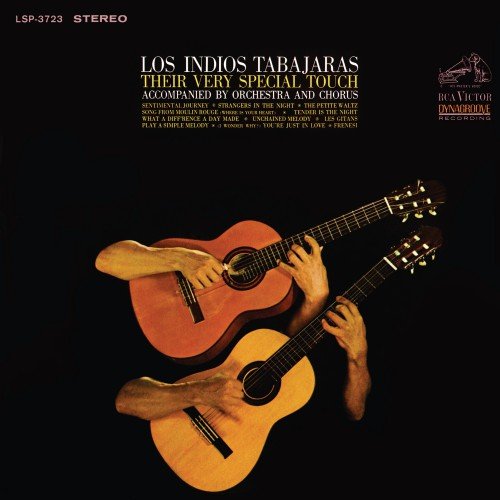Los Indios Tabajaras - Their Very Special Touch (2017) [Hi-Res]

Artist: Los Indios Tabajaras
Title: Their Very Special Touch
Year Of Release: 1967 / 2017
Label: RCA / Legacy
Genre: Pop, Easy Listening, Latin
Quality: FLAC (tracks) [192kHz/24bit]
Total Time: 28:21 min
Total Size: 1.02 GB
WebSite: Album Preview
Tracklist:Title: Their Very Special Touch
Year Of Release: 1967 / 2017
Label: RCA / Legacy
Genre: Pop, Easy Listening, Latin
Quality: FLAC (tracks) [192kHz/24bit]
Total Time: 28:21 min
Total Size: 1.02 GB
WebSite: Album Preview
01. Sentimental Journey (2:26)
02. Strangers In The Night (2:16)
03. Song From Moulin Rouge (Where Is Your Heart) (2:02)
04. Frenesi (2:04)
05. Play A Simple Melody (2:54)
06. Tender Is The Night (2:55)
07. (I Wonder Why?) You're Just In Love (2:39)
08. Unchained Melody (3:18)
09. Les Gitans (2:43)
10. The Petite Waltz (2:24)
11. What A Diff'rence A Day Made (2:40)
Certainly the most uncommon duo of Brazilian artists to have a solid international career, Los Indios Tabajaras was formed by the brothers Antenor Moreyra Lima (Mucapere) and Natalicio Moreyra Lima (Erundi). In the U.S. they had success in the early '70s with "Sakura-Sakura," and their biggest hit was the fox trot "Maria Helena," which won second place at the American charts and sold over one-and-a-half million copies. Their 48 LPs also sold millions of copies worldwide, and they toured South, Central, and North America, Asia, and Europe before settling in the U.S. Their eclectic act gathered Rimsky-Korsakoff, Chopin, De Falla, and Villa-Lobos with folk tunes and originals, performed in tuxedo and also half-naked with Indian ornaments. In the '60s, they also performed successfully at the San Remo Festival (Italy). Both self-taught musicians, they took their first contact with the violao (guitar) during their journey through the hinterlands of Cariri, Ceara, but had to give it away for a pound of beans. Having both studied music later, Mucapere was accompanied in the recording of his "Their Very Special Touch" by a full symphonic orchestra and vocal choir.
Indians from the Tabajara tribe, they left Ceara with their people in 1933, traveling on foot the almost 2,000 km to Rio de Janeiro. During the three years spent on the journey, they collected a number of regional musics. In Rio de Janeiro they were registered and baptized by the lieutenant Hildebrando Moreira Lima, from whom they took their Christian names. Their first public performance was in 1945, at the Radio Cruzeiro do Sul (Rio de Janeiro), when they were introduced as Indios Tabajaras, having been hired by the outing. In 1953, they recorded an album through Continental with the baiao "Tambor Indio" and the galope "Acara Cary" (both by Mucapere). In the next year they had success with the polka "Pajaro Campana" (public domain). After recording several other albums, they left in 1957 for a tour through Argentina, Venezuela, and Mexico. Having both studied music in the latter, Erundi wrote several classic pieces for guitar during that period . Moving on to the U.S., they performed for three years in that country, and returned to Brazil in 1960. They continued to move around, but ended up back in Brazil in 1968, where they recorded an album of Hawaiian songs; they moved to the U.S. soon afterwards. ~ Alvaro Neder
Indians from the Tabajara tribe, they left Ceara with their people in 1933, traveling on foot the almost 2,000 km to Rio de Janeiro. During the three years spent on the journey, they collected a number of regional musics. In Rio de Janeiro they were registered and baptized by the lieutenant Hildebrando Moreira Lima, from whom they took their Christian names. Their first public performance was in 1945, at the Radio Cruzeiro do Sul (Rio de Janeiro), when they were introduced as Indios Tabajaras, having been hired by the outing. In 1953, they recorded an album through Continental with the baiao "Tambor Indio" and the galope "Acara Cary" (both by Mucapere). In the next year they had success with the polka "Pajaro Campana" (public domain). After recording several other albums, they left in 1957 for a tour through Argentina, Venezuela, and Mexico. Having both studied music in the latter, Erundi wrote several classic pieces for guitar during that period . Moving on to the U.S., they performed for three years in that country, and returned to Brazil in 1960. They continued to move around, but ended up back in Brazil in 1968, where they recorded an album of Hawaiian songs; they moved to the U.S. soon afterwards. ~ Alvaro Neder
![Sam Most - But Beautiful (2025) [Hi-Res] Sam Most - But Beautiful (2025) [Hi-Res]](https://img.israbox.com/img/2025-12/12/n19esmi2zxvr716zw8citn0dv.jpg)



![Coco Chatru Quartet - Lost Christmas (2025) [Hi-Res] Coco Chatru Quartet - Lost Christmas (2025) [Hi-Res]](https://www.dibpic.com/uploads/posts/2025-12/1765719561_coco-chatru-quartet-lost-christmas-2025.jpg)



